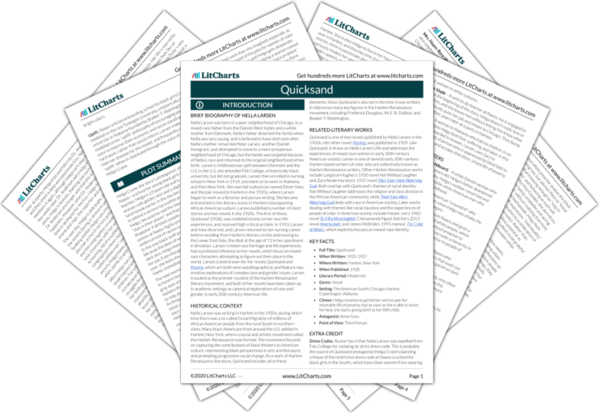Welcome to the LitCharts study guide on Nella Larsen's Quicksand. Created by the original team behind SparkNotes, LitCharts are the world's best literature guides.
Quicksand: Introduction
Quicksand: Plot Summary
Quicksand: Detailed Summary & Analysis
Quicksand: Themes
Quicksand: Quotes
Quicksand: Characters
Quicksand: Symbols
Quicksand: Theme Wheel
Brief Biography of Nella Larsen

Historical Context of Quicksand
Other Books Related to Quicksand
Key Facts about Quicksand
- Full Title: Quicksand
- When Written: 1925-1927
- Where Written: Harlem, New York
- When Published: 1928
- Literary Period: Modernist
- Genre: Novel
- Setting: The American South; Chicago; Harlem; Copenhagen; Alabama
- Climax: Helga resolves to get better and escape her miserable life of poverty, but as soon as she is able to leave her bed, she starts giving birth to her fifth child.
- Antagonist: Anne Grey
- Point of View: Third Person
Extra Credit for Quicksand
Dress Codes. Rumor has it that Nella Larsen was expelled from Fisk College for violating its strict dress code. This is probably the source of Quicksand protagonist Helga Crane’s damning critique of the restrictive dress code at Naxos (a school for black girls in the South), which bans black women from wearing bright colors.
Uplift. Naxos (a fictional boarding school for black girls) is modeled on the real Tuskegee University, a historically black university in Alabama founded by Booker T. Washington and modeled on his “uplift” philosophy of encouraging people of color to improve their economic and social standing through hard work, rather than social reform. Larsen makes no effort to hide her distaste for this model, and frequently criticizes the “uplift” ethos in Quicksand through the voice of protagonist Helga Crane.







